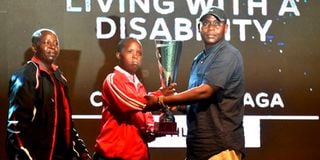Let's not forget girls and women with disabilities

Catherine Nyaga (centre) is awarded the best Sports Woman Living with a Disability in the girls' category during the Sports Personality of the Year (SOYA) Awards at the Gala in Mombasa on January 24, 2020.
What you need to know:
- Women and girls with disabilities still struggle to be in the crucial decision-making spaces.
- There are numerous barriers to their participation which are an impediment to their inclusion in society.
Tomorrow is, yet again, the International Women’s Day, when we celebrate the social, economic, cultural and political achievements of women and make a call to action for accelerating gender equality. And for women and girls with disabilities, the call is more urgent, recognising that their voice remains in the periphery; they are still under-represented in decision-making spaces.
Visibility of women and girls with disabilities is only starting to get strengthened, owing to recent years’ progression—more so through the adoption of the Convention on the Rights of Persons with Disabilities, which recognises the multiple discrimination that they face. The United Nation’s Committee on the Elimination of Discrimination against Women (Cedaw) also asks its state parties to provide information on them in their periodic reports.
Yet, women and girls with disabilities still struggle to be in the crucial decision-making spaces. There are numerous barriers to their participation—physical, attitudinal, information, communication or technological—which are an impediment to their inclusion in society. This in the face of little support.
In public and political life are fewer women with disabilities. When seeking public office, for example, they must work twice as hard to address attitudes that stem from entrenched cultural beliefs that isolate them.
Stigma and discrimination
In an interview some years back, the Kajiado County Woman Rep Janet Teiyaa spoke about propaganda initiated by her opponents to the effect that, according to their culture, it would be a taboo to elect to public office a woman with disability. That didn’t stop her from winning—a message that, with persistent advocacy, we can eliminate the rampant stigma and discrimination against persons with disabilities (PWDs) that, in a disproportionate manner, affects women and girls with disabilities.
There are many other spaces where the visibility of women and girls with disabilities must be strengthened. That includes issues around employment and livelihoods; climate change discussions; and access to healthcare, including sexual and reproductive health, as well as education and justice. Others include gender-based violence and how women and girls with disabilities adversely effected by the Covid-19 pandemic are going to be supported to get back their income and livelihoods.
Addressing systemic discrimination against women and girls with disabilities starts from the point where laws and policies identify intersectionalities, the multiple identities that human beings possess—that, one, she is a woman; two, she is a woman with disabilities—and acknowledging how such identities would result in multiple discrimination.
States and development partners must be willing to not only invest in tackling stigma and discrimination as it affects women and girls with disabilities but also go out of their way to consult and meaningfully involve them in all matters of concern to them.
Tomorrow, let us carry all of us along.
Ms Ombati, a disability rights advocate, is a member of the Kenya Network of Women with Disabilities. [email protected]





